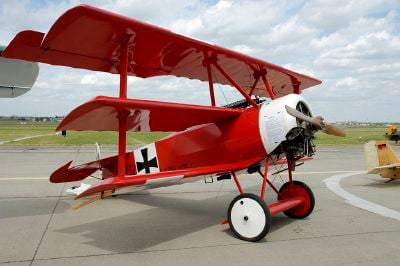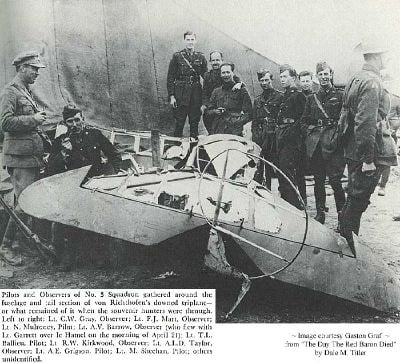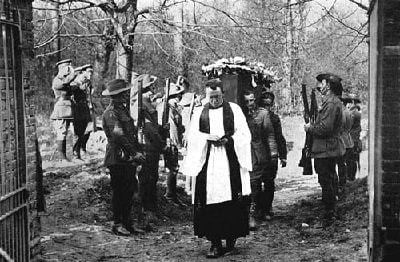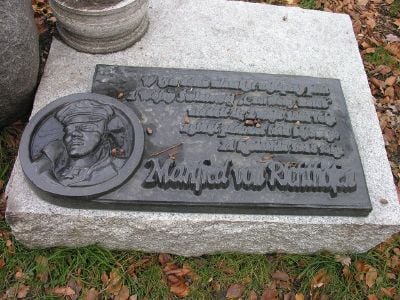Manfred von Richthofen
- "Red Baron" redirects here.
| Manfred von Richthofen | |
|---|---|
| May 2, 1892 – April 21, 1918 (aged 25) | |
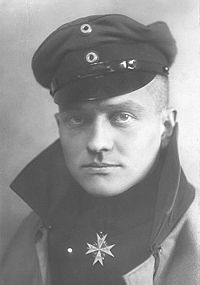
Richthofen wears the Pour le Mérite, the "Blue Max," Prussia's highest military order in this official portrait, c. 1917. | |
| Nickname | "Red Baron" |
| Place of birth | Breslau, Germany (now in Poland) |
| Place of death | Morlancourt Ridge, near Vaux-sur-Somme, France |
| Allegiance | Germany |
| Service/branch | Uhlan (Lancers) Luftstreitkräfte (Imperial German Army Air Service, forerunner of the Luftwaffe) |
| Years of service | 1911–1918 |
| Rank | Rittmeister (Cavalry Captain) |
| Unit | Jasta 11, Jagdgeschwader 1 |
| Commands held | Jasta 11 (01.1917)
Jagdgeschwader 1 (June 24, 1917 – April 21, 1918) |
Manfred Albrecht Freiherr von Richthofen (May 2, 1892 – April 21, 1918) was a German fighter pilot known as "The Red Baron." He was the most successful flying ace of World War I. Richthofen was a member of an aristocratic family with many famous relatives.
Von Richthofen was the most famous member of the Lutskreitkräfte, or Imperial German Army Air Service. Its members included Hermann Goering, who became commander of the Luftwaffe during World War II and Adolf Hitler's confidant and heir apparent.
The exploits of the "Red Baron" helped to popularize not only the dominant role that air power would play in warfare throughout the twentieth century and beyond, but the emerging culture of flight that would revolutionize travel and turn the world into a global community as well.
Name and nicknames
Freiherr (literally "Free Lord") is not a given name but a German aristocratic title, equivalent to a baron in other countries and the origin of Richthofen's most famous nickname: "The Red Baron." The German translation of Red Baron is "der Rote Baron" ▶. Richthofen is today known under this nickname even in Germany, although during his lifetime he was more often described in German as Der Rote Kampfflieger, (variously translated as the The Red Battle Flyer or The Red Fighter Pilot). This name was used as the title of Richthofen's 1917 "autobiography."
Richthofen's other nicknames include "Le Diable Rouge" ("Red Devil") or "Le Petit Rouge" ("Little Red") in French, and the "Red Knight" in English.
Early life
Richthofen was born in Kleinburg, near Breslau (now part of the city), Silesia, into a family of old Prussian nobility. When he was nine years old, he moved with his family to nearby Schweidnitz. The young Richthofen enjoyed riding horses and hunting as well as gymnastics at school. Richthofen excelled at parallel bars and won a number of awards at school.[1] In the protected game forests, he and his brothers, Lothar and Bolko, hunted wild boar, elk, birds, and deer. After receiving education at home as well as attending the local school at Schweidnitz, Richthofen began military training at age 11.[2] Upon completion of cadet training in 1911, he joined the Ulanen-Regiment Kaiser Alexanders des III. von Russland (1. Westpreußisches) Nr. 1 ("Uhlan Regiment Emperor Alexander III of Russia 1st Regiment, West Prussia, Uhlan Regiment Number 1"), a cavalry unit, and was assigned to the regiment's 3. Eskadron.[3]
When World War I broke out, Richthofen served as a cavalry officer on both the Eastern and Western Fronts. However, when traditional cavalry operations became obsolete due to machine guns and barbed wire, the Uhlans were used as infantry. Disappointed at his inability to participate more often in combat operations, Richthofen applied for a transfer to the Luftstreitkräfte (literally: Aerial Combat Forces), the "Imperial German Army Air Service," forerunner of the Luftwaffe. After a while his request was granted and he joined the flying service at the end of May 1915.[4]
Piloting career
Richthofen was initially an observer flying on reconnaissance missions over the Eastern Front from June to August 1915, with Fliegerabteilung 69 ("No. 69 Flying Squadron"). After his transfer to the Champagne front, he managed to shoot down a French Farman aircraft with his observer's machine gun, but was not credited with the kill, as it fell behind Allied lines.
He then trained as a pilot in October 1915. In March 1916, he joined Kampfgeschwader 2 ("No. 2 Bomber Geschwader") flying a two-seater Albatros C.III. Over Verdun on April 26, 1916 he fired on a French Nieuport, downing it over Fort Douaumont, although once again he gained no official credit. At this time he flew a Fokker Eindecker single-seat fighter.
After flying two seaters on the Eastern Front in August 1916 he met fighter pilot Oswald Boelcke. Boelcke, touring the East looking for candidates for his newly formed fighter unit, selected Richthofen to join a new Jagdstaffel ("fighter squadron"), Jasta 2. Richthofen won his first aerial combat over Cambrai, France, on September 17, 1916.
After his first victory, Richthofen ordered a silver cup engraved with the date of the fight and the type of enemy machine from a jeweller friend in Berlin. He continued this tradition until he had 60 cups, by which time the supply of silver in blockaded Germany was restricted.
Rather than engage in risky tactics like his brother, Lothar (40 victories), Manfred von Richthofen strictly observed a set of flight maxims (commonly referred to as the "Dicta Boelcke") to assure the greatest success for both squadron and individual fighter pilots. Contrary to popular imagination, he was not a spectacular or acrobatic pilot, as were others like his brother or the renowned Werner Voss. However, he was a fine combat tactician and squadron leader, as well as a superb marksman. In combat he philosophically viewed his aircraft as merely a platform from which to fire his guns. Typically, as was the case for most squadron leaders, he would dive in to attack from above with the advantage of the sun behind him, and with other Jasta pilots covering his rear and flanks.
On November 23, 1916, Richthofen downed his most renowned adversary, the British ace Major Lanoe Hawker VC, described by Richthofen himself as "the British Boelcke." The victory came while Richthofen was flying an Albatros D.II and Hawker was flying a D.H.2. After this engagement, he was convinced he needed a fighter aircraft with more agility, though this implied a loss of speed. He switched to the Albatros D.III in January 1917, scoring two victories before suffering a crack in the spar of the aircraft's lower wing. After this incident, Richthofen reverted to the Albatros D.II for the next five weeks. Richthofen scored one kill in the D.III on March 9, but the D.III was temporarily grounded for the rest of the month, so Richthofen switched to the Halberstadt D.II.
Richthofen returned to the Albatros D.III on April 2, 1917. He scored his next 22 kills in this type before switching to the Albatros D.V in late June. Following his return from convalescence in October, Richthofen was flying the celebrated Fokker Dr.I triplane, the distinctive three-winged aircraft with which he is most commonly associated, although he probably did not use the type exclusively until after it was reissued with strengthened wings in November. Despite the popular link between Richthofen and the Fokker Dr. I, only 20 of his 80 kills were made in this now-famous triplane. In fact, it was his Albatros D.III that was first painted bright red and in which he first earned his name and reputation.
Richthofen championed the development of the Fokker D.VII with suggestions to overcome the deficiencies of the then current German fighter aircraft.[5] However, he never had an opportunity to fly it in combat as he was killed just days before it entered service.
The Flying Circus
In January 1917, after his sixteenth confirmed kill, Richthofen received the Pour le Mérite ("The Blue Max"), the highest military honor in Germany at the time. That same month, he assumed command of Jasta 11, which ultimately included some of the elite of Germany's pilots, many of whom he trained himself. Several in turn subsequently became leaders of their own squadrons.
As a practical aid to easy identification in the melee of air combat, Jasta 11's aircraft soon adopted red colorations with various individual markings, with some of Richthofen's own aircraft painted entirely red. This practice soon had its use in German propaganda, even the RFC aircrew dubbing Richthofen "Le Petit Rouge."
Richthofen led his new unit to unparalleled success, peaking during "Bloody April" 1917. In that month alone, he downed 22 British aircraft, raising his official tally to 52. By June, he was the commander of the first of the new larger Jagdgeschwader (wing) formations, leading Jagdgeschwader 1 composed of Jastas 4, 6, 10 and 11. These were highly mobile combined tactical units that could be sent at short notice to different parts of the front as required. In this way, JG1 became "The Flying Circus," its name coming both from the unit's highly mobile nature (including the use of tents), and from its brightly colored aircraft. By the end of April, the "Flying Circus" also became known as the "Richthofen Circus."[6]
Richthofen was a brilliant tactician, building on Boelcke's tactics. But unlike Boelcke, he led by example and force of will rather than by inspiration. He was often described as distant, unemotional, and rather humorless, though some colleagues contend otherwise.[7]
Richthofen wounded in combat
On July 6, during combat with a formation of F.E.2d two seat fighters of No. 20 Squadron RFC, Richthofen sustained a serious head wound. He was then forced to land near Wervicq and was grounded for several weeks. The air victory was credited to Captain Donald Cunnell of No. 20, who was himself killed a few days later.
Although the Red Baron returned to combat in October 1917, his wound is thought to have caused lasting damage, as he later often suffered from post-flight nausea and headaches, as well as a change in temperament.
Author and hero
It was during his convalescence that Richthofen – probably with the help of a ghostwriter from a German propaganda unit – wrote his "autobiography," Der rote Kampfflieger.[8] Although Richthofen died before a revised version could be prepared, in 1933, his autobiography was published for the third time in Germany, titled Der Rote Kampffliegerhe. This version includes some autobiographical passages he wrote after the original publication of Der Rote Kampfflieger and before his death, repudiating the original version, stating that it was "too insolent" and that he was "no longer that kind of person." In 1969, historian Peter Kilduff published an English translation of the 1933 book titled The Red Baron.[9]
In 1918, Richthofen had become such a legend that it was feared that his death would be a blow to the morale of the German people. Richthofen himself refused to accept a ground job after his wound, stating that if the average German soldier had no choice in his duties, he would therefore continue to fly in combat. He had become part of a cult of hero-worship, assiduously encouraged by official propaganda. German propaganda circulated various false reports, including one that had the British had raising squadrons specially to hunt down Richthofen, offering large rewards and an automatic Victoria Cross to any Allied pilot who shot him down. Passages from his correspondence indicate he may have at least half believed some of these stories himself.
Death
Richthofen was killed just after 11 A.M. on April 21st, 1918, while flying over Morlancourt Ridge, near the Somme River.
At the time, the Baron had been pursuing (at very low altitude) a Sopwith Camel piloted by a novice Canadian pilot, Lieutenant Wilfrid "Wop" May of No. 209 Squadron, Royal Air Force. In turn, the Baron was spotted and briefly attacked by a Camel piloted by a school friend (and flight Commander) of May, Canadian Captain Arthur "Roy" Brown, who had to dive steeply at very high speed to intervene, and then had to climb steeply to avoid hitting the ground. Richthofen turned to avoid this attack, and then resumed his pursuit of May.
It was almost certainly during this final stage in Richthofen's pursuit of May that he was hit by a single .303 bullet, which caused such severe damage to his heart and lungs that it must have produced a very speedy death.[10] In the last seconds of his life, he managed to make a hasty but controlled landing in a field on a hill near the Bray-Corbie road, just north of the village of Vaux-sur-Somme, in a sector controlled by the Australian Imperial Force (AIF). One witness, Gunner George Ridgway, stated that when he and other Australian soldiers reached the aircraft, Richthofen was still alive but died moments later.[10] Another eye witness, Sgt Ted Smout of the Australian Medical Corps, reported that Richthofen's last word was "kaputt" ("finished") immediately before he died.[11]
His Fokker was not badly damaged by the landing, but it was soon taken apart by souvenir hunters.
No. 3 Squadron, Australian Flying Corps, as the nearest Allied air unit, assumed responsibility for the Baron's remains.
Who fired the fatal shot?
After 90 years of controversy and contradictory hypotheses, exactly who fired the fatal shot remains uncertain.
The RAF credited Brown with shooting down the Red Baron. However, Richthofen died following an extremely serious and inevitably fatal chest wound from a single bullet, penetrating from the right armpit and resurfacing next to the left nipple. If this was from Brown's guns, Richthofen simply could not have continued his pursuit of May for as long as he did.[10] Brown himself never spoke much about what happened that day, claiming "There is no point in me commenting, as the evidence is already out there."
Most experts now believe that Richthofen was killed by someone on the ground.[10][12] The wound through his body indicated that it had been caused by a bullet moving in an upward motion, from the right side, and more importantly, that it was probably received some time after Brown's attack.[10]
Many sources, including a 1998 article by Geoffrey Miller, a physician and historian of military medicine, and also a U.S. Public Broadcasting Service documentary made in 2003, have suggested that Sergeant Cedric Popkin was the person most likely to have killed Richthofen.[10][12] Popkin was an anti-aircraft (AA) machine gunner with the Australian 24th Machine Gun Company, and was using a Vickers gun. He fired at Richthofen's aircraft on two occasions: first as the Baron was heading straight at his position, and then at long range from the right. Popkin stated—in a 1935 letter, which included a sketch map—to the Australian official war historian, that he believed he had fired the fatal shot as Richthofen approached his position. Such a shot would have been from directly in front of the aircraft and could not have been the one that resulted in the Baron's death. However, Popkin was well placed to fire the fatal shot when Richthofen passed him for a second time on the right.[10][12]
One source, a 2002 documentary produced by the Discovery Channel suggests that Gunner W. J. "Snowy" Evans, a Lewis machine gunner with the 53rd Battery, 14th Field Artillery Brigade, Royal Australian Artillery is likely to have killed von Richthofen.[11] However, Dr. Miller and the PBS documentary dismiss these theories.[10][12]
Other sources have suggested that Gunner Robert Buie (also of the 53rd Battery) may have fired the fatal shot. There is now little support for this theory.[10][12] Nevertheless, in March 2007, the municipality of Hornsby Shire, in Sydney, recognized Buie, a former resident, as the man who shot down Richthofen. The Shire placed a plaque near Buie's former home in the suburb of Brooklyn.[13]
The commanding officer of No. 3 Squadron AFC, Major David Blake suggested initially that Richthofen had been killed by the crew of one of his squadron's R.E.8s, which had also fought Richthofen's unit that afternoon. However, this was quickly disproved, and, following an autopsy that he witnessed, Blake became a strong proponent of the view that an AA machine gunner had killed Richthofen.
Theories about Richthofen's last combat
Richthofen was a highly experienced and skilled fighter pilot—fully aware of the risk from ground fire. Furthermore he was fully in accord with his late mentor Boelcke's rules of air fighting, which were strongly against taking foolish risks. In view of all this, it is universally accepted that Richthofen's judgment during his last combat was uncharacteristically unsound in several respects.[14] Several theories have been propounded to account for this behavior - some of which are detailed below.
In 1999, a German medical researcher, Dr. Henning Allmers, published an article in British medical journal The Lancet, suggesting that it was likely brain damage from the head wound suffered by Richthofen in July 1917 (see above) played a part in the Baron's death. This theory was supported by a 2004 paper from researchers at the University of Texas. Richthofen's behavior after his injury was noted as consistent with brain-injured patients, and such an injury may account for his perceived lack of judgment on his final flight: flying too low over enemy territory and exhibiting target fixation.[15]
There is also a possibility that Richthofen was suffering from cumulative combat stress, which made him fail to observe some of his usual precautions. It is remarkable that one of the leading British air aces, Major Edward "Mick" Mannock, was also killed by ground fire on July 26, 1918 while crossing the lines at low level, an action against which he had always cautioned his younger pilots. And the most popular of all French air aces, Georges Guynemer, went missing on 11 September 1917, probably while attacking a two-seater without realizing some Fokkers were escorting it.
There is also a suggestion in Franks and Bennett's 2007 book,[14] that on the day of Richthofen's death, the prevailing wind was about 25 mph (40 km/h) easterly, rather than the usual 25 mph (40 km/h) westerly. This meant that Richthofen, heading generally westward at an airspeed of about 100 mph (160 km/h), was traveling over the ground at 125 mph (200 km/h) rather than the more typical ground speed of 75 mph (120 km/h). This was 50 mph (80 km/h) or 60 percent faster than normal and thus he could easily have strayed over enemy lines without realizing it, especially since he was struggling with one jammed gun and another that was only firing short bursts before requiring re-cocking.
An assessment of all these factors must include the circumstances of the time. At the time of Richthofen's death the front was in a highly fluid state, following the initial success of the German offensive of March–April 1918. The Baron may have been acutely aware that the battle he was engaged in was part of Germany's last real chance to win the war—in the face of Allied air superiority, the German air service was having great difficulty in acquiring vital reconnaissance information, such as the positions of batteries, and could do little to prevent Allied squadrons from completing very effective reconnaissance and close support of their armies.
Burial
In common with most Allied air officers, Major Blake, who was responsible for Richthofen's remains, regarded the Red Baron with great respect, and he organized a full military funeral, to be conducted by the personnel of No. 3 Squadron AFC.
Richthofen was buried in the cemetery at the village of Bertangles, near Amiens, on 22 April 1918. Six airmen with the rank of Captain—the same rank as Richthofen—served as pallbearers, and a guard of honor from the squadron's other ranks fired a salute. Other Allied squadrons presented memorial wreaths.
Richthofen's aircraft was dismembered by souvenir hunters. Its engine was donated to the Imperial War Museum in London, where it is still on display. The Royal Canadian Military Institute in Toronto, Ontario Canada owns the seat in which he died. The Institute also displays a side panel from the aircraft–signed by the pilots of Brown's squadron. The control column of Richthofen's aircraft is displayed at the Australian War Memorial Canberra.
In 1925, Manfred von Richthofen's youngest brother, Bolko, recovered the body and took it home. The family's first intention was to lay Manfred's coffin down at the Schweidnitz cemetery, beside the graves of his father (died in 1920) and his brother Lothar, who had been killed in a post-war air crash in 1922. But German authorities expressed a wish that the final place of rest for the body be the Invalidenfriedhof Cemetery in Berlin, where many German military heroes and leaders were buried. The family agreed, and Richthofen's grave remained in Berlin until 1975, when his body was exhumed and buried in his family's tomb at the Südfriedhof in Wiesbaden.
Number of victories
For decades after World War I, some authors questioned whether Richthofen achieved 80 victories, insisting that his record was exaggerated for propaganda purposes. Officially credited with 80 confirmed air combat victories.[5] Some claimed that he took credit for aircraft downed by his squadron or wing. However, in the 1990s, resurgence in Great War scholarship resulted in detailed investigation of many facets of air combat. A study conducted by British historian Norman Franks with two colleagues, published in Under the Guns of the Red Baron in 1998, concluded that at least 73 of Richthofen's claimed victories were accurate, with documented identities of the Allied airmen whom Richthofen had fought and defeated. There were also unconfirmed victories that could put his actual total as high as 100. The highest scoring Allied ace was Frenchman René Fonck, with 75 victories and the highest scoring British Empire fighter pilots were Mick Mannock with 65–73 kills and Canadian Billy Bishop, with 72.
It is also significant that while Richthofen's early victories and the establishment of his reputation coincided with a period of German air superiority, the majority of his successes were achieved against a numerically superior enemy, who were flying fighter aircraft that were on the whole better than his own.
Legacy
The "Red Baron" is one of the most famous aviators in history and the subject of numerous representations in music, film and other media. He already received numerous honors and award for his exploits. Richthofen's wartime exploits are the subject of legend and his moniker, the "Red Baron," is known throughout the Western world and is memorialized in all forms of media, from Charles Schultz's comic strip, Peanuts to numerous film adaptations.
At various times, several different Luftwaffe Geschwader have been named after the Baron:
- Jagdgeschwader 132 "Richthofen" (1 April 1936–1 November 1938)
- Jagdgeschwader 131 "Richthofen" (1 November 1938–1 May 1939)
- Jagdgeschwader 2 "Richthofen" (1 May 1939–7 May 1945)
- Jagdgeschwader 71 "Richthofen" (from 6 June 1959)—the first jet fighter unit established by the post-World War II (German Air Force); its first commander was the most successful ace in history, Erich Hartmann.
A Kriegsmarine (German navy) seaplane tender launched in 1941 was also named Richthofen.
Decorations and awards
- Prussian Pour le Mérite Order: January 12, 1917 (in recognition of his 16th aerial victory).
- Prussian Red Eagle Order, 3rd Class with Crown and Swords: 6 April 1918 (in recognition of his 70th aerial victory).
- Prussian Royal Hohenzollern House Order, Knight's Cross with Swords: November 11, 1916.
- Prussian Iron Cross, 1st Class (1914)
- Prussian Iron Cross, 2nd Class (1914): September 12, 1914.
- Bavarian Military Merit Order, 4th Class with Swords: April 29, 1917.[16]
- Saxon Military St. Henry Order, Knight's Cross: April 16, 1917.
- Württemberg Military Merit Order, Knight's Cross: April 13, 1917.
- Saxe-Ernestine Ducal House Order, Knight 1st Class with Swords (issued by the Duchy of Saxe-Coburg and Gotha): May 9, 1917.
- Hesse General Honour Decoration, "for Bravery"
- Lippe War Honour Cross for Heroic Deeds: October 13, 1917.
- Schaumburg-Lippe Cross for Faithful Service: October 10, 1917.
- Bremen Hanseatic Cross: September 25, 1917.
- Lübeck Hanseatic Cross: September 22, 1917.
- Austrian Order of the Iron Crown, 3rd Class with War Decoration: 8 August 1917.
- Austrian Military Merit Cross, 3rd Class with War Decoration
- Bulgarian Bravery Order, 4th Class (1st Grade): June 1917.
- Turkish Imtiaz Medal in Silver with Sabres
- Turkish Liakat Medal in Silver with Sabres
- Turkish War Medal ("Iron Crescent"): November 4, 1917.
- German Army Pilot's Badge
- German Army Observer's Badge[17]
- Austrian Field Pilot's Badge (Franz Joseph pattern)
Notes
- ↑ Nicolas Wright, The Red Baron (London: Sidgwick & Jackson, 1976. ISBN 0283982985), 31.
- ↑ Wright, 30.
- ↑ Preußen. Kriegsministerium. Geheime Kriegs-Kanzlei, Rangliste der Königlich Preußischen Armee und des XIII. (Königlich Württembergischen) Armeekorps für 1914. Mit den Dienstalterlisten der Generale und Stabsoffiziere und einem Anhange enthaltend das Reichsmilitärgericht, die Marine-Infanterie, die Kaiserlichen Schutztruppen und die Gendarmerie-Brigade in Elsaß-Lothringen. Nach dem Stande vom 6. Mai 1914. Auf Befehl Seiner Majestät des Kaisers und Königs (Berlin: Ernst Siegfried Mittler und Sohn, 1914), 400.
- ↑ Manfred von Richthofen, Red Fighter Pilot: The Autobiography of the Red Baron (St Petersburg, FL: Red and Black Publishers, 2007, ISBN 978-0979181337).
- ↑ 5.0 5.1 David Baker, Manfred von Richthofen: The Man and the Aircraft He Flew (McGregor, MN: Voyageur Press, 1991, ISBN 1871547067).
- ↑ Greg VanWyngarden, ‘Richthofen’s Circus’: Jagdgeschwader Nr 1 (Osprey Publishing, 2004, ISBN 978-1841767260).
- ↑ Karl Bodenschatz, Hunting With Richthofen: Sixteen Months of Battle with J G Freiherr Von Richthofen No. 1 (London: Grub Street, 1998, ISBN 1898697973).
- ↑ Manfred von Richthofen, Der rote Kampfflieger (Independently published, 2019 (original 1917), ISBN 1077872755).
- ↑ Manfred von Richthofen, Peter Kilduff (trans.), The Red Baron (Doubleday & Company, 1969).
- ↑ 10.0 10.1 10.2 10.3 10.4 10.5 10.6 10.7 10.8 M. Geoffrey Miller, "The Death of Manfred von Richthofen: Who fired the fatal shot?" Sabretache: Journal and Proceedings of the Military History Society of Australia XXXIX (2) (1998). Retrieved December 7, 2023.
- ↑ 11.0 11.1 "Unsolved History: Death of the Red Baron," Discovery Channel, 2002.
- ↑ 12.0 12.1 12.2 12.3 12.4 "Who Killed the Red Baron? Explore Competing Theories" NOVA, 2003. Retrieved December 7, 2023.
- ↑ Mark Day, "Unsung No.1 with a bullet" The Australian, April 7, 2007.
- ↑ 14.0 14.1 Norman Franks and Alan Bennett, The Red Baron's Last Flight (London: Grub Street, 1997, ISBN 1904943330)
- ↑ Henning Allmers, "Manfred Freiherr von Richthofen's medical record—Was the "Red Baron" fit to fly?" The Lancet 354 (9177) (August 7, 1999): 502–504. Retrieved December 7, 2023.
- ↑ Neal W. O’Connor, "The Aviation Awards of the Grand Duchies of Baden and Oldenburg (Foundation of Aviation World War I.)" Aviation Awards of Imperial Germany in World War I and the Men Who Earned Them – Volume VI. (Stratford, CT: Flying Machines Press, 1999. ISBN 0764316265), "errata and addenda," 371–374. For many years, World War I aviation historians believed Richthofen had received the 3rd Class with Crown and Swords of the Bavarian Military Merit Order prior to his submission for the Military Max Joseph Order. However, recent research has proved that he received the usual class of that order common for an officer of his rank: the 4th Class with Swords of the Bavarian Military Merit Order.
- ↑ No record or photographic evidence has been seen to indicate Richthofen qualified for this badge. However, he successfully completed the training and served for nearly five months as an observer before retraining as a pilot.)
ReferencesISBN links support NWE through referral fees
- Baker, David. Manfred von Richthofen: The Man and the Aircraft He Flew. McGregor, MN: Voyageur Press, 1991. ISBN 1871547067
- Bodenschatz, Karl. Hunting With Richthofen: Sixteen Months of Battle with J G Freiherr Von Richthofen No. 1. London: Grub Street, 1998. ISBN 1898697973
- Franks, Norman, and Alan Bennett. The Red Baron's Last Flight. London: Grub Street, 1997. ISBN 1904943330
- Franks, Norman, Hal Giblin, and Nigel McCrery. Under the Guns of the Red Baron: Complete Record of Von Richthofen's Victories and Victims. London: Grub Street, 1998. ISBN 1840671459
- Kilduff, Peter. The Red Baron: Beyond the Legend. London: Cassell, 1994. ISBN 0304352071
- O’Connor, Neal W. "The Aviation Awards of the Grand Duchies of Baden and Oldenburg (Foundation of Aviation World War I.)" Aviation Awards of Imperial Germany in World War I and the Men Who Earned Them – Volume VI. Stratford, CT: Flying Machines Press, 1999. ISBN 0764316265
- Titler, Dale. The Day the Red Baron Died. New York: Ballantine Books, 1970. ISBN 0345249232
- VanWyngarden, Greg. ‘Richthofen’s Circus’: Jagdgeschwader Nr 1. Osprey Publishing, 2004. ISBN 978-1841767260
- Von Richthofen, Manfred. Der rote Kampfflieger. Independently published, 2019 (original 1917). ISBN 1077872755
- Von Richthofen, Manfred, Peter Kilduff (trans.). The Red Baron. Doubleday & Company, 1969. ASIN B07DWPCGGP
- Von Richthofen, Manfred. Red Fighter Pilot: The Autobiography of the Red Baron. St Petersburg, FL: Red and Black Publishers, 2007. ISBN 978-0979181337 (in English)
- Wright, Nicolas. The Red Baron. London: Sidgwick & Jackson, 1976. ISBN 0283982985
External links
All links retrieved April 29, 2025.
- Who Killed the Red Baron? NOVA
- Manfred Von Richthofen The Aerodrome
- The Red Baron (2007) Official Website of the movie
- The Kaiser's Hero: Manfred von Richthofen
Credits
New World Encyclopedia writers and editors rewrote and completed the Wikipedia article in accordance with New World Encyclopedia standards. This article abides by terms of the Creative Commons CC-by-sa 3.0 License (CC-by-sa), which may be used and disseminated with proper attribution. Credit is due under the terms of this license that can reference both the New World Encyclopedia contributors and the selfless volunteer contributors of the Wikimedia Foundation. To cite this article click here for a list of acceptable citing formats.The history of earlier contributions by wikipedians is accessible to researchers here:
The history of this article since it was imported to New World Encyclopedia:
Note: Some restrictions may apply to use of individual images which are separately licensed.
